Mountain Bikes: The early versions of mountain bikes were a far cry from today’s trail monsters. They have changed a lot since the early days when riders tackled California’s Mt. Tamalpais on toughed-up beach cruisers. Those riders used to skid to a stop with their feet because the bikes’ brakes would overheat.
Key Takeaways
- Mountain bikes have come a long way from being just modified beach cruisers.
- Today’s mountain bikes are packed with special features and the latest tech for different styles and terrains.
- There are various types of mountain bikes, like cross-country and downhill, each designed for specific uses.
- Things like suspensions, wheel sizes, and the material of the frame have all changed how mountain bikes ride.
- Now, electric mountain bikes (eMTBs) are here, making it even more exciting to hit the trails.
Evolution of Mountain Bikes
Mountain bikes started simple and rough compared to today’s high-tech models. In the 1970s, folks in Northern California began to change heavy bikes for rough hills. They added features to their bikes for off-road adventures. These early bikes were called “ballooners,” “klunkers,” and “dirt bombers.”
From Modified Beach Cruisers to Modern Marvels
These riders from the 1970s wanted to explore more than paved roads could offer. They worked on their bikes, making them tough with bigger tires and stronger parts. This tinkering began the journey to our modern mountain bikes.
Pioneers of Off-Road Cycling
In the 1970s, riders who loved off-road adventures laid a strong foundation. Their love for nature and bikes led to significant advancements in mountain biking. Their passion inspired others to keep improving bikes for rough terrains.
Cross-Country Mountain Bikes
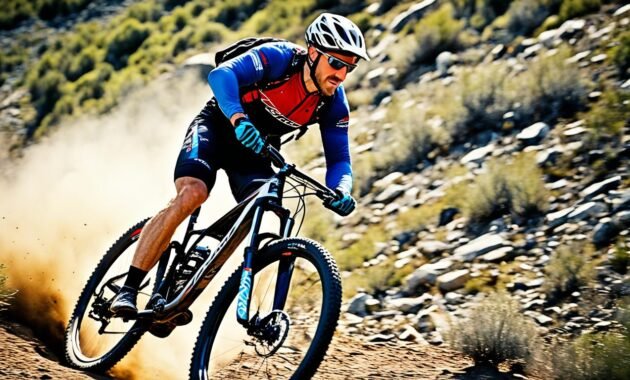
Cross-country (XC) mountain bikes are all about efficiency. They turn your pedaling into speed well. For riders who tackle long, hilly journeys, XC bikes are perfect. They focus on using lightweight components and efficient suspension. This way, riders don’t waste unnecessary energy.
Lightweight and Efficient for Long Distances
Cross-country bikes are light and smart. This means riders can pedal efficiently for a long time. These bikes have suspension systems with short travel. Shorter travel means every pedal is powerful. XC bikes respond quickly when the rider puts in effort. This makes them great for long rides filled with climbing.
Prioritizing Climbing Prowess
In cross-country mountain biking, climbing well is key. XC bikes are made to climb difficult terrain easily. Their geometry and suspension design are all about climbing prowess. So, riders can easily handle steep hills and tricky rocky paths. The lightweight and effective design of XC bikes means they are perfect for tackling tough mountain trails.
Trail and All-Mountain Bikes
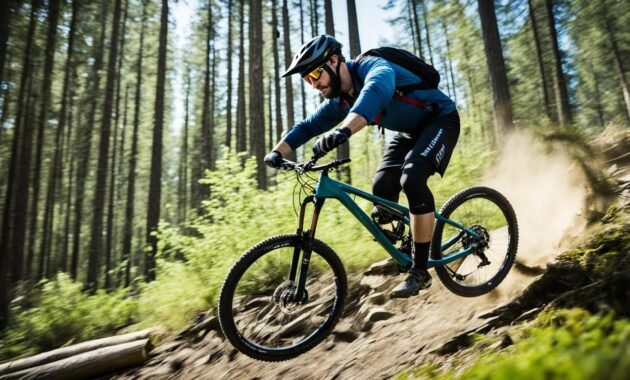
Trail and All-Mountain bikes are like the Goldilocks of the mountain biking world. They’re made to handle everything, striking a perfect balance. This includes the right amount of suspension, precise components, and design to ride any terrain.
Balanced Geometry for Versatility
The design of these bikes is key for being able to ride almost anywhere. Their geometry mixes suspension travel and angles just right. This makes them great for both tough trails and general mountain adventures. Riders can enjoy going down hills, up them, and around turns easily.
They usually have 120mm to 160mm of suspension travel. This is enough to provide comfort and control on various types of terrain. It’s a great mix for going through normal trails and tackling enduro riding. That’s why these bikes are a top pick for those looking for a bike that can do it all well.
Enduro Mountain Bikes
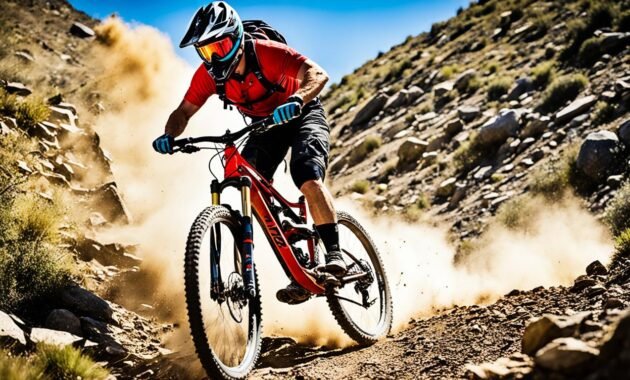
Enduro bikes have evolved for intense mountain biking races known as enduro. In these races, climbing is just a small part. The focus is on fast and tech-filled downhill sections. These bikes are perfect for going down hills fast. But, they’re also good at climbing, so riders can get back up easily.
Built for Rugged Descents
Enduro bikes come with big suspension parts, offering 160mm to 180mm of travel, front and back. This much travel and a slack head tube angle make them steady on hard descents. Their design is all about going downhill fast with confidence.
Combining Climbing Capabilities with Downhill Performance
These bikes are great at downhill but also good at climbing. The suspension helps a lot when you’re pedaling up. It keeps you moving without losing energy. Enduro bikes have a 1x drivetrain too. This setup makes the bike lighter and easier to handle uphill.
Enduros balance downhill speed with uphill climbing. They’re a great choice for riders who love fast downhills and also want to tackle the hard uphills. They offer a mix of downhill bike performance and trail bike adaptability.
Downhill Mountain Bikes
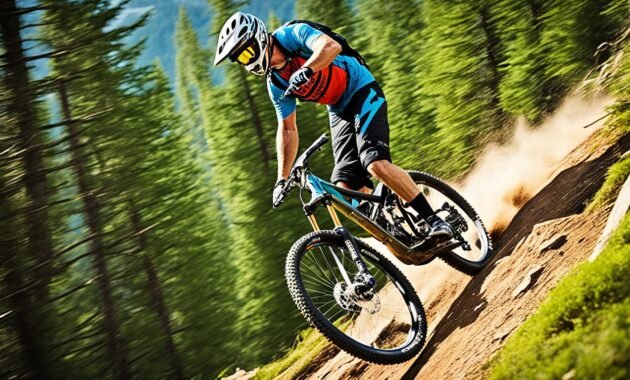
Downhill bikes are made for thrilling rides down the mountain. They’re not big on pedaling up but are focused on downhill adventures. These bikes are carried up the mountain by car, ski lift, or with a hike. This lets the rider enjoy the exhilarating ride back down.
Purpose-Built for Gravity-Fueled Adventures
Downhill mountain bikes are all about confident riding at high speeds down steep paths. They have a design that makes going downhill a breeze. With super suspension, strong parts, and mighty brakes, they’re ready for rough terrains. Riding uphill is not their strength as they’re built for downhill sport.
For those adventurers who love steep downhill rides, a proper downhill mountain bike is their best bet. These bikes are not good for long rides or for going up hills. But for heart-pounding downhill experiences, these bikes are unmatched.
Mountain Bikes
The sport of mountain biking has seen big changes over the years. One major change is the variety of wheel sizes available. Bikers now have options like 26-inch, 29-inch, and 27.5-inch wheels. Each size has its own special benefits for different riders and riding styles.
Exploring Different Wheel Sizes
29-inch wheels have become a favorite among mountain bike riders. They roll well and grip better over rough areas. These bigger wheels also make the bike more steady, especially when moving fast. On the other hand, the 27.5-inch size is a good middle ground. It combines the best of both the 26-inch and 29-inch, offering easy maneuvering and good speed.
The Rise of 1x Drivetrains
The mountain bike world is seeing a shift to 1x drivetrain systems. These new setups have just one front chainring and a big rear cassette. They make riding simpler and easier to maintain. This change is happening because these 1x systems cover a wide range of gears. They also help make bikes lighter and less likely to drop a chain.
Geometry Tailored for Different Riding Styles
The geometry of a mountain bike is key to its performance. The head angle and reach are especially important. They impact how the bike handles and how comfortable the rider feels. Manufacturers adjust these details for bikes meant for quick and nimble trails or for tough, long mountains.
Suspension Systems
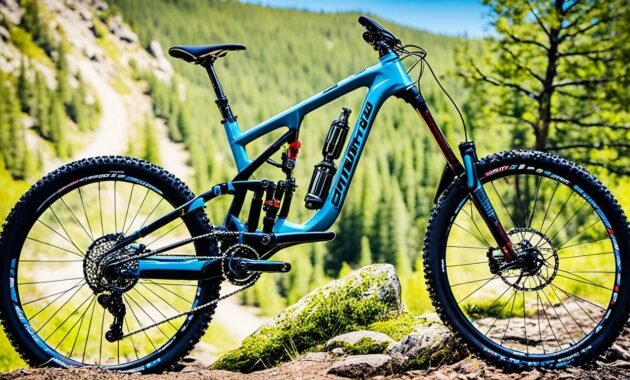
Mountain bike suspension systems have improved greatly over the years. They started with just rigid frames. Now, we have full-suspension designs. These changes have made riding experiences better, enhancing traction and control on trails.
From Rigid to Full Suspension
Back in the early days, mountain bikers rode on rigid frames. These frames didn’t offer any shock absorption. This meant riders had to be very skilled to handle bumpy terrain. The 1980s brought a big change with the introduction of front suspension forks. Now, riders had more control and comfort on rough paths.
Later, rear suspension was added, creating full-suspension bikes. These bikes have both front and rear suspension. They allow better energy transfer and grip on different grounds. This type of bike is now top choice for many. It offers a smooth and capable ride.
Improving Traction and Control
The progress in suspension technology has improved how mountain bikes perform. No matter the type of suspensions, they all help in better traction and control. They absorb the shock of bumps, keeping the wheels on the ground. This gives riders more stability and control.
The suspension travel, measured in millimeters, is key for handling varied terrain. More suspension travel means the bike can handle rough trails. Less travel is better for more even ground and efficient riding.
Electric Mountain Bikes
Electric mountain bikes (eMTBs) have changed the game. They let riders go further and explore tougher trails. These bikes blend the excitement of regular mountain bikes with extra power from an electric motor.
Extending Your Riding Range
eMTBs help riders go longer distances and climb harder hills. They work with your pedaling to give you a push when you need it most. This means you can cover more ground and take on new adventures. It makes mountain biking more exciting and accessible.
Pedal-Assist Technology
The key to eMTBs is the pedal-assist tech. It smoothly combines the electric motor with the bike’s movement. This tech kicks in just enough power to make your ride smoother but still feels natural. And, you can adjust the settings to fit your style and the terrain, making the whole journey fun and easy.
Switching to eMTBs means you can ride up steep hills with ease. You can handle rough trails better and even go faster downhill. This tech changes the game, opening up new trails and exciting adventures. It’s a big win for mountain biking enthusiasts everywhere.
Frame Materials and Components
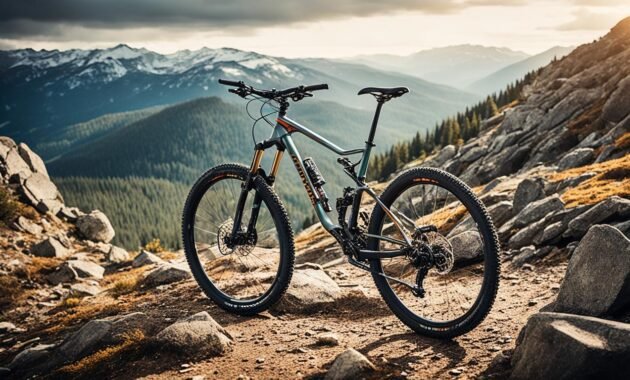
The materials and parts of mountain bikes are crucial for how they ride and last. There are two key materials: aluminum and carbon fiber. Each gives the bike unique benefits and challenges.
Aluminum vs. Carbon Fiber
Aluminum frames are strong, stiff, and cost less. They suit riders who tackle tough terrain often because of their durability. Carbon fiber frames are light and super strong. They make the bike feel quick and efficient.
Choosing the Right Components
The components like the suspension and Brakes play a big role too. They affect how well the bike rides and moves. It’s important to pick these based on how you plan to use your bike. This ensures you’ll have fun out on the trails.
| Component | Considerations |
|---|---|
| Suspension | Travel, damping, and lockout functionality to match the terrain and riding style |
| Brakes | Disc brake size, caliper type, and pad compound for consistent stopping power |
| Drivetrain | Gear range, number of chainrings, and cassette options for efficient climbing and descending |
| Wheels | Wheel size, rim width, and spoke count for optimal traction, stability, and durability |
| Tires | Tread pattern, casing, and width to match the terrain and riding conditions |
Choosing the right frame and components lets bikers craft a machine that performs well, feels comfortable, and is reliable on the trails.
Also Read : Master BMX Tips And Tricks For Beginners
Conclusion
The story of mountain bikes is truly amazing. They started as adapted beach cruisers and have evolved into advanced machines. These bikes cover various styles like cross-country, trail, all-mountain, enduro, and downhill. Each meets the needs of today’s mountain bikers.
Every mountain bike has unique features for specific uses. These include suspension systems, wheel sizes, and frame geometries. They make riding better, no matter the terrain. The introduction of electric mountain bikes has opened new doors for mountain bikers. Now, they can explore in ways not possible before.
Riding mountain bikes is becoming more thrilling as it progresses. We can expect to see better frame materials, components, and technology. These will improve the riding experience and allow riders to do more on trails. No matter your style, from cross-country to enduro, or even electric mountain bikes, there’s a mountain bike out there for you.
FAQs
Q: What are the different types of mountain bikes available?
A: There are various types of mountain bikes including hardtail, dual suspension, full-suspension, cross country, trail, and more.
Q: What is the difference between a hardtail and a full-suspension mountain bike?
A: A hardtail mountain bike has a front suspension fork only, while a full-suspension mountain bike has both front and rear suspension for better shock absorption.
Q: How do I choose the right mountain bike for me?
A: Consider factors like your riding style, terrain you will ride on, budget, and preferred features such as suspension type and bike size to find the best mountain bike for you.
Q: What are some popular mountain bike brands?
A: Popular mountain bike brands include Santa Cruz, Cannondale, and brands like Shimano known for their quality components.
Q: What is the significance of suspension travel in mountain bikes?
A: Suspension travel refers to how far the suspension fork can compress and is crucial for absorbing shocks on technical terrain while maintaining control and comfort.
Q: Can I purchase mountain bikes online?
A: Yes, many bike shops and online retailers offer a wide selection of mountain bikes for sale online, making it convenient to find the perfect bike for you.
Q: How important is brake selection in mountain bikes?
A: Brakes are crucial for your safety while riding, so choose brakes that offer reliable stopping power and control depending on your riding style and preferences.
Source Links
- https://en.wikipedia.org/wiki/Mountain_bike
- https://www.jensonusa.com/blog/learn/types-of-mountain-bikes
- https://www.rei.com/learn/expert-advice/mountain-bike.html